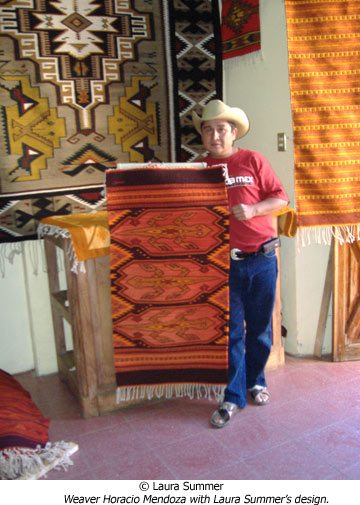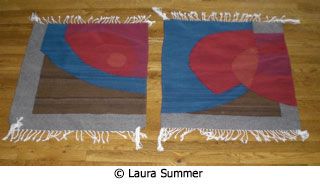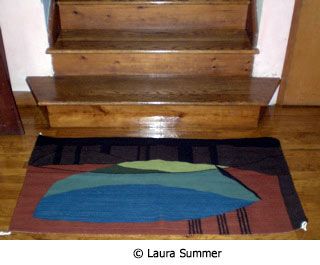Mexican Design: Textiles

One of the best-known items for decorating that's made its way from Mexico into homes around the world is the intricately patterned woven rug. It's one of those "little things" that can bring the sunshine and warmth of Mexico, along with the country's deep traditions, into a home, brightening a room even the coldest climate.
While some rug-making in Mexico now relies on artificial dyes, you can still find weavers who work only with natural dyes, as their ancestors have done for centuries. These dyes, taken from plants, are often very expensive, as it takes a great deal of the plant to create a small amount of dye. The cochineal, a small beetle that lives in Mexico, is responsible for the red color, which can be one of the most labor-intensive and costly to produce. But it also gives some of the most arresting color.
In Mexico, it remains true that each town has its own tradition of craft; some towns are known for pottery, some for silver crafting, and some, like Teotitlan del Valle, for their weaving.
Teotitlan, about twenty minutes outside of Oaxaca City in the southern state of Oaxaca, has been a center for rug-making since pre-Hispanic times, when the people of the village paid their tribute to the Aztecs in cloth. The population there is still nearly all Zapotec; to be "bilingual" in this town means a person speaks both Zapotec and Spanish, and many of the ancient Zapotec customs are still observed, although they're for the most part blended with Catholicism.
The Zapoteco word for Teotitlan del Valle — "xiguie'e" — means "magical place," and a visit to one of the artisan's workshops reveals why. An artisan will take you upstairs to the workshop, where she will explain how the cochineal bug implants itself on a nopal cactus leaf, then is removed to make the dye. She motions for you to hold out your palm, and presses a tiny snail-shell into it until a bright red stain appears. Mix a little lemon juice into the dye, and it turns orange; a little alkaline, and it turns to a startling purple. It's like a magic act of color.
The designs and patterns of many of the rugs date back hundreds of years, and many of these designs can be brought in to a room that doesn't have Mexican design as its dominant theme. The trick is to work with the colors and patterns, and not to let any one pattern overtake the look of the room. For example, a brightly-colored rug with blues and reds could work in a room with white walls and white or off-white furniture, or a more plainly-patterned rug could work in a room with more pattern going on in the furniture.

Some of the most distinctive of the Mexican rugs are done in simple blacks, whites, and greys, and these could work well in a room with elegant, subdued tones.
But the traditional patterns don't appeal to every contemporary home stylist, a fact which caught the interest of artist Laura Summer when she was visiting Oaxaca and met one of the artisans of Teotitlan by happenstance. She had taken a bus with her husband and son to the village, and there her husband got to talking to the man in charge of the public restrooms. As they talked about rug-making, the man offered to take the Summers to his workshop in his home. He closed up the restrooms and off they went, up the dusty, cobbled street.
His name is Horacio Mendoza, and he is one of the premier weavers in the village. Summer was struck by his passion for his work, as well as by his remarkable talent.
"Horatio showed us his loom, and with an uncanny ability at pantomime showed how the natural dying is done with cochineal and indigo, how the patterns are laid out and the weaving accomplished. It was striking to watch his hands on the loom — there was never hesitation. He had completely penetrated his art," Summer said.

When she told him she was a painter, he immediately suggested that she could design a rug, and he could weave it.
"So back I went to Oaxaca and found in the market a big piece of paper and some colored pencils. I created two designs for these two small rugs and the next day got back on the bus to Teotitlan."
"If he was surprised to see me so soon, he didn't show it," she said. "We discussed color and design, and he asked me how long I would be in Oaxaca. I told him five more days, and he said to come back in the evening on the last day. And I did. And there were the rugs, beautifully complete."

She left him with another design for a rug to go at the bottom of her stairs in her living room. In a few months, the rug arrived at her home.
Summer is still in touch with the Mendozas, and sends another design about once a year, as now she's beginning to get requests from people who see her rugs and want to bring the tradition of weaving into their homes, but with a more up-dated design.
Summer's experience shows how traditional materials — which we value for their durability and their simple, rustic beauty — can be re-worked to a contemporary look. And this approach may help the Zapotec weavers of Teotitlan del Valle continue to thrive into the next century, and beyond.







